User Tools
Games for MSX by Andrey Rodionov
Table of Contents
Русская версия находится здесь: Игры для MSX Андрея Родионова 2022
A versão portuguesa pode ser encontrada aqui: Jogos para MSX por Andrey Rodionov
English version
Copyright (C) 1988–2022 Andrey Rodionov
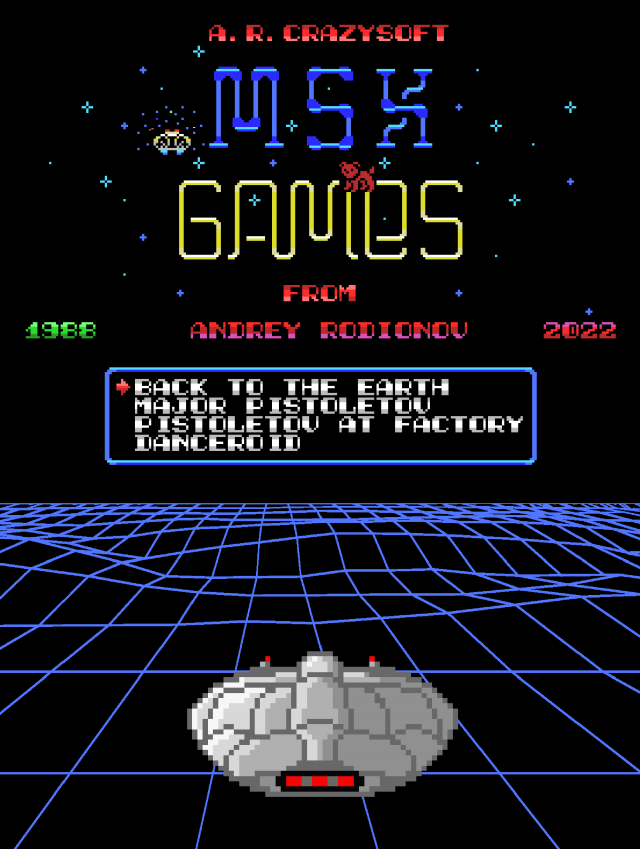
| Games, version 2.11A (2023-02-12) |
|---|
| Play online |
| Disk image |
About Author
 | Andrey Rodionov June 3,1954 – May 29, 2023. Composer, programmer, system administrator, author, and manager of many projects. Member of Direction of Electroacoustic music Association under the Union of Composers of Russia. WorldSkills Expert in BlockChain Competence Author of games for MSX personal computers (1988–2022) |
Introduction
A brief history of games development
Until recently, the source code of the games was thought to be lost, but in 2021 the author was lucky enough to find the diskettes with the source code of all his programs for MSX platform. This has resulted in the new versions of “Major Pistoletov” v1.07 and “Back to the Earth” v2.16, as well as the updated versions of some of the author’s development tools, including the “Pattern Composer” v3.04 (PAC).
New versions of the games are presented to your attention. (The original 1988 game disk (in Russian) remains available for download on the author’s website — http://rodionov.info). The main changes to the games and the reasons why these changes were made are listed in the “New versions of games and walkthrough key points” part of the game manual.
A short look into game creation history
All 4 games, that were mentioned earlier, had been developed over 30 years ago, starting from their scripts and ending with graphics design, music and software — within just a few months. It became possible thanks to the previously developed SDK by the same author, that was called “Maestro”. The SDK had been written in C and Assembly programming languages. The games were also developed in C programming language using the author’s software libraries, macros and utilities, including the character pattern editor called “Pattern Composer” (PAC) — all included into the “Maestro” package.
Developer’s notes for all games
The main feature of these games is that the walkthrough of any of them never completely repeats, because a random number generator is used for the levels and objects creation. For example, objects in chests and keys that open the doors in the games about Major Pistoletov or planets and their location in the game Back to the Earth as well as the behavior of their inhabitants. In Danceroid such objects appear randomly to prevent the exit of the Danceroid from the maze.
So, even playing the same game, each time the player finds himself in a situation when the walkthrough is completely different. That means the tactics or even the strategy can radically change from trial to trial. This is especially noticeable in the game Back to the Earth, where each universe has to be previously explored and studied in order to complete the return mission.
In addition, not every game is determined to be passable — the player may find himself in desperate situations if he lacks any resources that he did not have time to collect or replenish in advance. In this case, the only way out is to “capitulate” by pressing the ESC key, and start the game from the beginning, finding yourself again in a slightly different situation from the previous one.
Perhaps this explains the fact that these rather old games are still popular nowadays and people continue to play them because, unlike some other games with strictly deterministic behavior leading to success, in these games a lot depends on luck and the logic of the player's behavior depends on the situation.
New versions of the games and walkthrough key points
All new versions of the games no longer check port 1 for the connected joystick (it is exclusively dedicated for mouse connection), which previously prevented the cursor keys from working properly. Only port 2 is now intended for connecting a joystick. This is displayed by animated pictures on the right and left side of the game selection menu on the Game Loader. In addition, you can switch on/off the sound with the TAB key, Mouse can be used for control in case MSX2 is used.
The games “Back to the Earth”, “Major Pistoletov” and “Pistoletov at the Factory” have undergone major changes, In “Back to the Earth” and “Pistoletov at the Factory” those changes were very significant.
“Danceroid” has also seen a major revamp, including the introduction of point–n–click mouse driven interface.
Game Controls
All games are controlled by using the cursor keys, SPACE, GRAPH and ESC key. In addition, the games use the STOP key to switch to the Pause mode and the X key to jump to and return from hyperspace in the new version of the Back to the Earth game. You can return to Game Loader by pressing CTRL+SELECT key combination.
Thanks
The Author would like to thank:
- Igor Bezhenar who helped to translate, localize, and edit the game and the game’s manual to make them available for the English speaking auditory.
- “Mosaic of System Administration” project and Alexey Podrezov [RBSC Team] personally for their help in bringing the game package back to its original state (as in 1987)
- Matheus Santos for his great job to make the game manual available in Portuguese.
- Alexey Sysoyev for the great help in many aspects of this gameset preparation.
- ATroubleshooter for editing, testing and other support.
- The release of this games on an MSX cartridge became possible thanks to Pyhesty's wonderful UniMapper project.
- All other fans who were involved directly or indirectly.
“Back to the Earth” — User guide and key points of the walkthrough
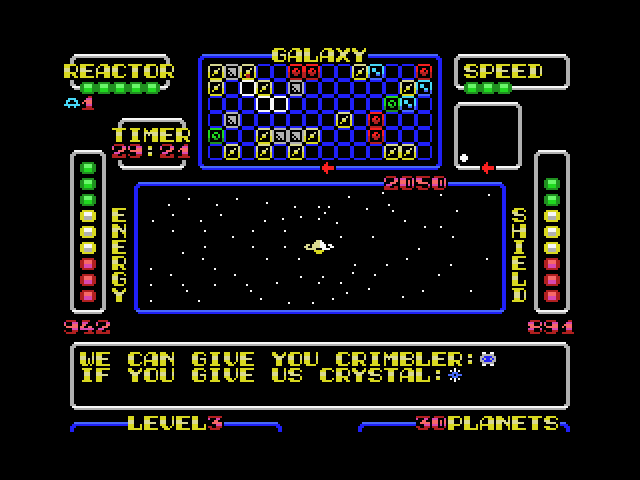
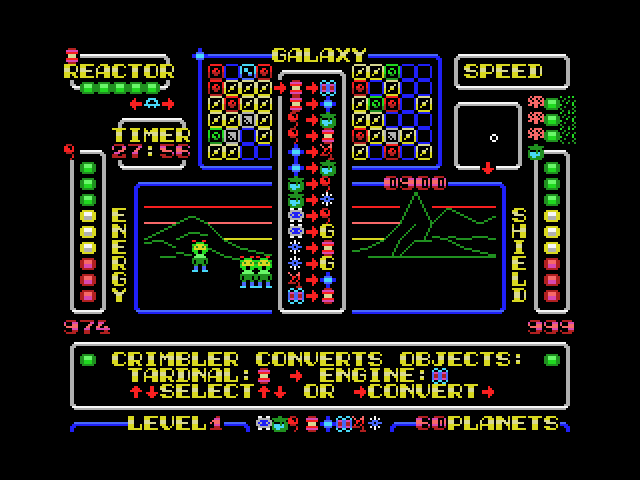
The situation your spaceship got into is outlined on the second page of the screen but requires some clarification. As a result of a hyperspace storm, you found yourself in an alien galaxy which is enclosed and locked in ordinary space. This means that flying out of its upper border you find yourself on its lower border and flying out of the left border you find yourself on the right border and vice versa.
You can only fly out of there by going into hyperspace, but unfortunately, as a result of the storm, you lost your Hyper–Engine, a Hyper–Receiver that can receive a signal from Earth, as well as a memory Crystal where you need to record this signal in order to set the starship back to Earth. In addition to all these troubles, you also need to send a Signal to the Earth so that the Earth will answer you via Hyper–Radio and give you guidance coordinates of the Solar system.
But all not so bad — the rest of the equipment works. The Reactor is operational, there is enough energy for protective shield and normal movement around the galaxy. Moreover, the galaxy is inhabited by intelligent beings who have everything you need — the Hyper–Engine, the Hyper–Receiver, the Crystal, and they can even send a broadcast Signal to Earth! But what is especially important, you can communicate with the inhabitants of this distant galaxy using your onboard computer and Hyper–Radio.
In addition to supplying you with the necessary items, they can restore the Shield, fix the onboard reactor, but usually they want something for exchange. And very often it is something that you have no idea about. Even though most of the inhabitants of the planets want to change something, there are planets and space objects on which they can help you completely disinterestedly and free.
During the game, remember the following:
- Your maximum speed depends on the health of the onboard reactor, but if you have a Hyper–Engine, you can go into hyperspace even at minimum speed.
- Do not fly close to planets using the near–view radar at a speed higher than the minimum. Landing is possible at a minimal speed only. When you approach an object and the speed is higher than minimal, then your protection will be damaged. Landing is possible by aligning the red dot of the starship with the white dot of the object on the near–view radar and pressing the DOWN arrow.
- When a planet or object becomes visible not only as white dots on the near–view radar, but also on the Main screen as planets or objects, you can find out from their inhabitants what they have for you and what they need by pressing the SPACE key.
- In addition, by holding down the SPACE bar and moving around the galaxy map with the cursor arrows, you can always remember what was offered to you where you have already been. Keep in mind that if you have already taken something from someone, then after a while this resource may reappear there again.
- If the conditions are suitable for you — land on the planet or object with the DOWN cursor arrow at a minimal speed, look for the inhabitants with the LEFT and RIGHT cursor arrows and get what you need from them. After that, take off with the cursor arrow UP.
- The inhabitants of the Red Planets usually help and do everything for free but be careful — sometimes they can start taking your starship apart. In this case, fly away from them as soon as possible!
- If you obtain a Hyper–Engine, you can fly through the galaxy much faster by going into hyperspace with the X button, but how much you fly depends only on you and the moment when you press the X button again to exit the hyperspace.
- Keep tracking of the amount of energy, protection, and real–time counter. If you run out of energy, you will die. When the protection is reduced, the onboard reactor will begin to break down and there will be irregular interference in communication, and after the time expires on the real–time timer, the Earth will stop waiting for you and you will not be able to return. Also, keep in mind that if the reactor malfunctions occur in hyperspace due to inadequate protection, you will lose the Hyper–Engine — be careful!
- If you have collected everything you need and sent a signal to Earth — get out into hyperspace with the X button and you will return to Earth automatically. As long as you have enough energy, and the reactor would not fail when flying in hyperspace!
All items that you collect on the planets are divided into 2 types.
Objects you need to come back to Earth:
 Hyper–Receiver |  Crystal |  Hyper–Engine |
and Artefacts, the purpose of which may be initially unknown to you:
 Crimbler |  Bgrl–psh |  Scragla |  Furtl–ke |  Tardnal |
All Objects and Artefacts can be collected and stored in the hold of your starship and stay there until you use them or convert them into others. At the 1st and 2nd difficulty levels of the game, small tips on the usage of Artefacts appear on the indicators in the starship cabin. At Level 3, there are no such hints since it is believed that you should already know which Artefacts for what purposes can be used. To use Artefacts or convert them, press the GRAPH button, and select “USE” or “DROP” with the cursor buttons. You can use and throw away Artefacts only when landing on planets, it cannot be done in space.
- Crimbler is a special Artefact — you can transform (convert) Objects and Artefacts from one to another with it. In addition, only with Crimbler you can create a Gravy–Shield, which will protect the hold of your starship from breaking into by intruders. If you choose “Use Crimbler”, then options for converting one Object to another will appear. That can be controlled with the cursor buttons. In the current version of the game, you can convert any Object or Artefact to any other one by using sequential conversion. However, keep in mind that each transformation requires some amount of Energy.
- Apart from you, there are some other objects that fly in space. On the near–view radar, they are visible as blue or green moving dots, and on the Main Screen, you can see them in an enlarged size. The “Blues” are hostile to you and after colliding with them your defense decreases, and the Objects and Artefacts that you collected with so much difficulty may disappear from the hold they broke into. On the contrary, the “Greens” are friendly and when docked with your starship they can refuel you with Energy, restore your Defense and even wish you good luck. Therefore, direct contacts with the “Blue” (Enemies) are very undesirable, and with the “Green” (Friends) are very useful.
- In order to fight the Enemies, your starship has a weapon. One of them is the Scan–Cannon, which is always available and can be manually controlled by pressing the GRAPH button with the RIGHT and LEFT cursor arrows. When matching its sight with a flying object on the Main Screen, the Cannon shoots itself — no other buttons need to be pressed. But be careful — if there is no Hyper–Receiver on board, the Cannon will be equally successful in destroying Enemies and Friends! However, if you have a Hyper–Receiver with a built–in “friend–o–foe” recognition system, then the Cannon will not fire at Friends under any circumstances! If you manage to acquire a Crystal, then the Scan–Cannon will work in an automatic mode of scanning space and searching for hostile objects. But keep in mind that if you have a Crystal, but no Receiver, then the Cannon, when scanning, will destroy everyone in a row — both Enemies and Friends. Be reasonable and careful, because if you destroy more than 3 Friends, they will turn into the most dangerous Enemies that will not be recognized by the signs of “friend–or–foe”!
- Another weapon is Gravy–Shield, which you can install with Crimbler. Gravy–Shield can be installed on a starship by converting Crystals or Crimbler itself into it. Unlike the Scan–Cannon, which does not always have time to track objects and sometimes allows them to come too close to the starship, Gravy–Shield works all the time and completely automatically when someone attempts to board and break open the hold, guaranteeing the destruction of Enemies in 100% of cases. Like the Hyper–Receiver, it has its own system of recognition “friend–or–foe” and will not harm the docking Friends but will blow your Enemies into dust. However, Gravy–Shield has a limited resource and is capable of destroying no more than 3 objects. After that, it disappears and must be installed again.
- Scan–Cannon and Gravy–Shield are both energy weapons. Usage of each result in low energy consumption. Therefore, in particular, you cannot use the Scan–Cannon without recharging it with Energy. In general, a systematic “hunt” for Enemies, which reduces the likelihood of encounters with them, is best organized near some planet on which you can be charged with Energy or having Bgrl–psh Artefact on board. When landing on any planet, you can replenish the energy of your starship with that Artefact.
How to play — Additional explanations and recommendations
As you can see, this game contains quite a lot of rules and complex logic. The randomized universes live their own lives, and you need to adapt to it and do everything in order to return to Earth. It would seem that not so much is needed — to collect only 3 items: Receiver, Crystal, Engine and send a Signal to Earth. But it may not be so easy. Therefore, I will allow myself to explain something and give some recommendations.
- It’s better to take care about protection and weapons just right away. Even if you are the first to come across an overvalued Artefact of Crimbler, convert it to Gravy–Shield. Otherwise, it could be stolen, and you will remain without Gravy–Shield, and without Crimbler. So let you have at least Gravy–Shield first. You’ll be able to find another Crimbler somewhere else later.
- If you can get the Crystal, but you don’t have the Receiver, then think 100 times — whether to take it immediately or postpone until you finally will obtain the Receiver. Otherwise, in the Cannon automatic mode, you can begin to destroy your Friends, which will lead to very unpleasant consequences, as already explained above. An alternative is to temporarily transform the Crystal into something else with the help of Crimbler.
- You can see statistics on the presence of the key Objects and Artefacts in the galaxy right after the game starts. But do not be upset if you didn’t have time to look at it or forgot to read it attentively. You can see it again by entering Pause mode. Please note that statistics is generated dynamically and displays the actual number of key Objects in the galaxy at the current moment (excluding those that are already in your hold!).
- In addition, keep in mind that if you have already received some Artefacts somewhere and now, they tell you there: “We have nothing for you yet”, then the situation may change. There comes a certain time “X” when all civilizations renew resources, they can share with you. But this time “X” is repeated not so often, and it is necessary to wait on purpose sometimes. Although, there are cases when this time comes right after your landing on the planet. Then you may be offered the Artefact or Object that you just received for the second time in a row. It's not a mistake. It's just time “X” has come.
- Note that the difficulty levels of the game differ not only in the number of planets in the galaxy (the fewer there are, the less the possibility of exchanging and obtaining the necessary objects), but also in the size of the hold. With a hold size of only 4 slots on the 3rd difficulty level, some very difficult situations may happen when you have to throw or give away something very necessary!
- At the 1st and 2nd difficulty levels, after receiving Artefacts, small hint icons appear. Those icons can be seen in the upper left corners of the Energy, Shield, Reactor level bars and on the Galactic Map. The hints can explain how this Artefact can be useful and what it can be used for. There are no such hints at Level 3 — it is believed that if you are playing at Level 3, you no longer need such explanations.
- You’d better learn the transformation of Objects with the help of Crimbler. If you master the art of converting Objects perfectly and become a Master of Conversion, this will facilitate many tasks for you — you can convert any Objects and Artefacts into any others. Including even those that you need to return to Earth. But remember — using and converting Objects and Artefacts requires a calm environment and is possible only when landed on planets. This cannot be done in space. Using items and converting them is carried out by holding down the GRAPH button.
- When you start a new game, on the Galactic Map in front of you, you can see a completely unexplored galaxy over which you fly “blindly” without knowing where and what civilizations are located. Moving in this way, you can often find yourself in quadrants (sectors) that do not contain any planets and civilizations. Or you can meet civilizations that are not of interest to you at the moment. This is especially important for the 2nd and 3rd levels of difficulty, as there are much fewer planets than on the 1st. In this situation, the Furtl–ke Artefact can be of great help, which contains a map of the galaxy and, when used, can display it on the Galactic Map of your starship. However, do not think that this will make you aware of what is being offered there. This will become known only when you visit there yourself, and in some cases land on the planet. You will be able to move around the galaxy more purposefully, though.
- Your Hyper–Receiver is able to distinguish Friends from Enemies, working in conjunction with the Scan–Cannon, which starts to operate in automatic mode when there is a Crystal on board. Communication with discovered civilizations is established automatically when planets are in the same quadrant with the ship and became visible on the spacecraft's Main screen. Civilizations is established automatically when planets are in the same quadrant with the ship. To communicate with distant civilizations outside your quadrant, in any case, you need to press and hold the SPACE key while moving around the Galactic Map with the arrow keys. In places you have already visited, you would receive answers from civilizations, and the quadrant indicator on the Galactic Map would flash green. Otherwise, it will be red or yellow. Inter–galaxy communication can be used both in space flight and while on planets. But it is more convenient to do this on planets, of course.
- If you have already sent a Signal to Earth, this will be indicated by a flashing red antenna indicator at the top of the screen between the reactor status bar and the Galactic Map. Please note this event is neither an Object nor an Artefact and is not displayed in any way in the hold.
- The indicator of the switched–on Scan–Cannon is located above the countdown timer. If the icon between the arrows is red, then the Scan–Cannon will destroy all objects unknown to it — both Enemies and Friends, if it is blue, then only hostile flying objects will be destroyed (the latter happens if there is a Hyper–Receiver on board that recognizes signals “friend–or–foe”). To the left of the Scan–Cannon indicator, counters of destroyed objects will appear — blue for Enemies and green for Friends. If you destroy more than 3 Friends, then the green indicator will turn to red, and your life can become much more difficult.
- The state of Gravy–Shield is highlighted above the defense scale and is indicated by a short vertical scale of 3 green indicators, showing how many hostile objects Gravy–Shield is still able to reflect. After the possibilities of Gravy–Shield are exhausted (3 hostile objects destroyed), it will disappear from the screen, and it will be possible to restore it only by reinstallation with the help of Crimbler.
- About protection — the quality of communication and the operation of the reactor depend on its state. Troubles begin at defense levels less than 600. First, there is interference in communication, then the Reactor begins to break down, which in turn determines the maximum speed of a starship in ordinary space. The state of the Reactor does not affect the operation of the Hyper–Engine, but if the Reactor malfunctions occurs in hyperspace, then you will lose the Hyper–Engine and fall into ordinary space.
- In version 2 of the game, it became possible to accelerate and go into hyperspace directly from the orbits of the planets. The on–board computer makes sure that the starship does not increase speed in normal space until it leaves orbit. In addition, it became possible to orient the direction of the further movement of the spacecraft while in the landing position on the planet and panning the view with the RIGHT and LEFT arrows.
- Please keep in mind that due to the fact that the galaxy is closed on itself, the shortest path to the quadrant you have chosen can sometimes lie across the boundaries of the galaxy.
- Few words about the game score. The current score is displayed in the upper right on the frame of the Main Screen in the form of a 4–digit number. The final value is calculated after arrival on Earth. Points are awarded for any purchases and conversions. Points are also added for the destroyed Enemies minus the destroyed Friends. Special purchases (Crimbler) and actions (Signal sending, Gravy–Shield installation, filling the galaxy map with Furtl–ke) are specially noted. During the final escape to hyperspace and after arriving on Earth, points are increased by minimizing the time used to complete the mission and the remaining Energy + Protection. Therefore, it is in your best interest to return to Earth as quickly as possible with good reserves of Energy and Protection. For games on levels 2 and 3 at the very beginning of the game, additional bonus points are given. It should be noted that for the entire time of testing the game, the author himself never scored more than 9000 points. If anyone succeeds — congratulations!
Some tips for increasing your score:
- Each new Object that appears in the hold, even after conversion, increases the score.
- Each new sending of the Signal to the Earth increases the score.
- If you still have Crimbler before entering hyperspace to return to Earth, then you can either convert it to Bgr–pshsh which can maximize your Energy supply or get additional bonus points after returning to Earth.
- Arrange a “hunt” for the Enemies — each Enemy you destroy not only reduces the further likelihood of meeting them, but also increases the score. Sometimes, especially at high levels, it is worth starting the game with this to reduce the likelihood of theft of items from the hold. However, it should be borne in mind that such a hunt is best done with a Hyper–Receiver on board, which will not allow you to accidentally destroy Friends.
Game strategy and tactics
Considering the feedback from several game testers indicating that the game entry threshold is rather high, the author finds it necessary to supplement this manual with a chapter dedicated directly to game’s Strategy and Tactics. In it, you will find some tips and tricks to play more efficiently. It is also worth mentioning that many gameplay objectives become way easier with the help of Crimbler, which allows you to convert Objects and Artefacts one into another. The rules of conversion are described in Appendix 1.
- As we already noted, probably the first thing you’d like to do is to install Gravy–Shield, which will safeguard you from at least three attempts by hostile spaceships to board you and pillage your ship’s hold. Until you do that, you’ll have to shoot the Enemies in manual mode with a Scan–Cannon (holding GRAPH and using LEFT/RIGHT arrow buttons). Additionally, it would be very helpful to have Hyper–Receiver, which won’t let you accidentally shoot friendly crafts.
- However, to install Gravy–Shield you’ll need Crimbler and Crystal. That’s why finding a Crimbler, and a Crystal are the higher priority objectives. Since you’ve got both Crimbler and Crystal, just convert a Crystal to Gravy–Shield using Crimbler. But if you already got a Crimbler, and still have no Crystal, then it is possible to turn Crimbler itself into Gravy–Shield directly. Although, such a use of Crimbler isn’t always preferable — especially if there’s the only Crimbler in a whole Galaxy! (See statistics in the beginning of the game or in Pause mode, pressing STOP) Crimbler would reappear though, over time, with the same civilization you first found it, but you’ll have to wait for it rather long, probably. Also note that there is no option to convert any Object or Artefact into Crimbler (this is prohibited by rules of conversion).
- Finding Crystal is a slightly less priority task, because you can obtain it not only from Galaxy inhabitants directly, but also convert from Scragla, and Scragla, in turn, can be converted from something else, if you’ve already got Crimbler.
- Yet another important task is to find an Artefact called Furtl–ke, using it to load Galaxy map into your on–board computer and navigate purposefully. Needless to say, loading The Map using Furtl–ke results in acquiring a “non–material” Object that takes up no room in the hold.
- Sending the Signal to Earth is also “non–material” action and doesn’t take up space in the hold. The Signal can be sent only by Communicators’ civilization (space stations in the form of bound blue spinning spheres). Well–timed and early Signal transmission is especially important on 3rd level of difficulty, when you don’t have much space in the hold and there can be not enough room to keep something that “Communicators” demand in exchange for their service. In this case, you might probably have to get rid of something really necessary.
- Acquiring Hyper–Engine is also an important task, but of a lower priority. Without Hyper–Engine it’s impossible to return to Earth, but you can normally travel within the Galaxy. Although if you have it, you can travel faster with less energy consumption. Besides that, flying in hyperspace is safer, because there you will never encounter Enemies. Should be mentioned though, not every encounter result in boarding by Enemies and pillaging the hold. Sometimes such encounters end up with just a small loss of your Defense. Hyper–Engine can be both obtained from Galaxy inhabitants and converted from an Artefact called Tardnal.
- The presence of Hyper–Receiver on board of your spacecraft is not only required to return to Earth, but also won’t let you shoot friendly ships neither in Cannon auto–scan mode, nor manually! Hyper–Receiver can be both obtained from Galaxy inhabitants or converted from an Artefact called Furtl–ke.
- Some Artefacts are useful to have in the hold for your starship resources recovery: Bgrl–psh to recharge Energy, Scragla to recharge shields, Tardnal for reactor repairs. These operations are done without using Crimbler or consuming any Energy.
- If you have collected all 3 Objects required to go back to Earth (Crystal, Hyper–Receiver, Hyper–Engine) and have sent the Signal, you may enter the hyperspace and automatically return to Earth. But, if there’s still time remaining, you can continue the mission to increase the score by collecting more Objects, converting them, destroying enemy crafts and doing other actions that add points to your score. The important thing is that it is advisable to collect additional points only when well–armed, so as not to lose what you have already collected for the return. The Gravity Shield must be active, and both the Crystal and the Hyper Receiver must be on board to selectively shoot Enemies. Before making the final decision to return, you are recommended to replenish your Energy and recharge your Shields to get bonus points on arrival back home.
Couple of tactical advices:
- There are some situations, when you are so low on Energy, that it doesn’t suffice to get to the place where you can charge it. If this happens, you should drop your speed to zero and, not spending Energy, wait for friendly spacecrafts to appear and dock to you and help you to recover your Energy state.
- Don’t try yourself to dock with your Friends. This is usually impracticable. You should just wait when they appear in your quadrant and dock to you themselves. It happens rather frequently and is always a good surprise. Friends will help you to refill the Energy or charge the Shields, depending on what is the worse problem.
- The Conversion of Objects, which is Energy consuming, is convenient to perform on Energy–rich planets or having an Artefact Bgrl–psh for restoring Energy state.
- Sometimes, in–game process it is required to think about further mission, quadrant exploration consequences, where and when to replenish your resources, conversion chains etc. You’d better do that in a calm atmosphere being on a planet, not flying through space. Although, besides that, you can hit STOP, entering the PAUSE mode. While in PAUSE mode, the current statistics are displayed showing the availability of crucially important Objects and Artefacts in Galaxy. Pressing any key exits PAUSE mode. You can switch to PAUSE mode even after arriving back to Earth to evaluate the post–game condition of the Galaxy you just returned from.
Appendix 1. Usage and conversion of Objects and Artefacts
Using Artefacts and converting Objects is only possible in the landed position of a craft, while on planets or space stations. You can’t do it during the flight. To use Artefacts, press and hold GRAPH, choose an Artefact with arrow keys and hit DOWN arrow key. On the other hand, if you just need to free some space in the hold, you can push the Up–arrow button to throw away the Artefact. Throwing Artefacts is not so bad — for each discarded Artefact, you are awarded an additional bonus in the form of compensation for your losses. It’s impossible to throw out Objects (Crystal, Hyper–Receiver, Hyper–Engine), just Artefacts (Bgrl–psh, Scragla, Tardnal, Furtl–ke, Crimbler). If you want to throw out of the hold an Object exactly – you’ll have to convert it into some Artefact first, using Crimbler.
The purpose and properties of Objects and Artefacts:
| Object | Purpose |
 Hyper–Engine | Hyperspace flights |
 Hyper–Receiver | Receiving Signal from Earth, “friend–or–foe” identification |
 Crystal | Recording Signal from Earth, enables Cannon “autoscan mode” |
| Artefact | Properties |
 Crimbler | Converts (transforms) Artefacts and Objects |
 Bgrl–psh | Refill Energy stock |
 Scragla | Recover Shields |
 Tardnal | Repair Reactor |
 Furtl–ke | Loads Galaxy map into you onboard computer’s memory |
Converting Objects one into each–other is done by Crimbler Artefact. For that, you need to Use Crimbler and, still holding GRAPH, select using LEFT/RIGHT arrow keys one of the items from your ship’s hold (Artefacts and Objects) to convert into another.
Artefact conversions table:
| Original Artefact | Conversion option 1 | Conversion option 2 | ||
 Crimbler |  |  Bgrl–psh |  |  Gravy–Shield |
 Bgrl–psh |  |  Scragla |  |  Tardnal |
 Scragla |  |  Bgrl–psh |  |  Crystal |
 Tardnal |  |  Hyper–Engine |  |  Furtl–ke |
 Furtl–ke |  |  Hyper–Receiver |  |  Scragla |
Object conversions table:
| Original Object | Conversion option 1 | Conversion option 2 | ||
 Crystal |  |  Tardnal |  |  Gravy–Shield |
 Hyper–Receiver |  |  Furtl–ke | ||
 Hyper–Engine |  |  Tardnal |
Appendix 2. “Back to the Earth” — the history of the creation of version 2
The author created and further improved this game primarily for himself. Sometimes I just wanted to spend time easily and not boringly, consciously fighting with an opponent in the form of a random number generator. Isn't it nice to feel smarter than a machine! Therefore, it would be just right to write a detailed essay about how and what thoughts came to the Author's head, what he wanted to add, how it was implemented and how he struggled with the lack of RAM while trying to remain within the framework of the MSX standard and not use the capabilities of MSX2, including Memory mapper and 9938 video processor advantages. But then it would be a completely different game and it would have to be done in a completely different way. Therefore, the Author tried to limit himself to only a brief listing of new features and some comments on their use.
- The first thing I wanted to do when I found the source code for this old game of mine was to add the visibility of a starship on the Galactic Map while flying in hyperspace so it would be possible to return to normal space not at random point, but exactly to the planned place. In addition, the control of entering and exiting hyperspace was purposefully removed from the cursor control buttons and moved to the X button to prevent accidental exits into hyperspace when accelerating to maximum speed. Also, the percentage values of speed were removed, and a universal graphic scale appeared instead. All this did not cause any particular difficulty and was done fairly quickly.
- However, after this, the idea arose that it would be nice to give some useful properties to Artefacts that were previously collected in the galaxy just for the sake of exchange. Thus, the Artefact Bgrl–psh had the ability to charge the starship with energy, Scraggle — to restore protection, Tardnal — to repair the reactor, and Furtl–ke — to show the Galactic Map. But due to specially created restrictions on the dimensions of the holds of starships, it became necessary not only to be able to “use” these Artefacts, but also to throw them out of the hold. Sometimes right on the heads of the inhabitants of the planets.
- But this seemed to me not enough and I decided to give one of the Artefacts called Crimbler special properties for converting some Objects and Artefacts into others. Conversion options were set by a special custom line in the data file, which was loaded by the program at the very beginning. However, by this time most of the key settings had already been transferred to this data file and could be easily edited using the PAC without changing the program code. Basically, these were the settings for the probability of occurrence of various events and the behavior of objects in the game.
- After that, it became clear that with so many different options for creating galaxies, as well as the properties of their objects and inhabitants, it is necessary to add not only the selection of the difficulty level for the player, but also an automatic check of the “passability” of the entire game by the number of key objects generated in the galaxy by random number detectors. In the case of an insufficient number of such key critical objects, the galaxy was re–generated until the game became “passable”.
- It would seem that we can stop at this… But I wanted something else. And this “something else” became “Unknown objects”, randomly flying around the galaxy, upon collision with which there was not only some loss of the level of protection, but the loss of the Objects collected by “hard work” from the broken hold. Boarding and break–ins did not always happen, though. But those which happened became extremely offensive… Therefore, it was decided to create a weapon!
- The first weapon was Gravy–Shield. This is such a wonderful thing and when someone tries to board, it blows a burglar into dust with a 100% probability, always and under any circumstances. Moreover, it does it automatically and does not require manual intervention. But Gravy–Shield also had a drawback — its installation on board the starship was enough for only 3 hits on burglars, after that it had to be reinstalled. You could install Gravy–Shield only if there was Crimbler on board.
- Therefore, the second weapon was the Scan–Cannon. It did not require installation and was always present on board. Manual control of the Cannon (with the GRAPH key pressed) makes it somewhat difficult to change course during flight, but it allows you to deal with hostile objects quite effectively, of course, if you have time to track their appearance. By the way, both Gravy–Shield and Scan–Cannon are energy weapons and little by little they take a certain amount of energy from the energy reserves of the starship. So, using them endlessly without refueling with energy is impossible. But, on the other hand, the more you destroy Enemies, the less likely you will meet them on your way.
- However, the Scan–Cannon could and should have been improved in order not to be distracted by the search and destruction of hostile objects. Therefore, if there is a Crystal on board, then scanning and destruction of Enemies flying in your sector of the galaxy occurs automatically. The Cannon does not always have time to track the appearance of new objects in the automatic scanning mode, though. In this sense, it is not as effective as Gravy–Shield and sometimes allows hostile objects to approach the starship. In addition, there are some nuances in the use of automatic weapons, which will be discussed below.
- After hostile objects and means of dealing with them appeared in the game, a reasonable thought arose — why should only Enemies fly around the galaxy? What about Friends? And then the “Friendly objects” were created. Once docked with you, they can refuel you with energy or restore your protection (depending on the worst level of each) and even wish you luck! At the same time, Gravy–Shield, upon close contact, recognizes them as “Friends” and never tries to destroy them. However, the Scan Cannon detects “Unknown objects” at a great distance and is unable to independently identify a Friend or Enemy in front of it. It destroys everyone. But the Hyper–Receiver helps to avoid such mistakes, if you have one on board — it has a “friend–or–foe” recognition system and will not allow the Cannon to shoot at friendly objects under any circumstances. But God forbid you to destroy accidentally or intentionally more than 3 Friends! With the help of Hyper–Radio, such news spreads across the galaxy very quickly and former friends turn into the most dangerous enemies — after all, neither Gravy–Shield nor the Receiver with a Cannon will recognize them as Enemies! In such a situation, it is better to turn off all the automatics and become a “bad guy” — to beat everyone in a row in the hope that over time there will be much less of both and meets with them will occur much less often.
“Major Pistoletov” — User guide
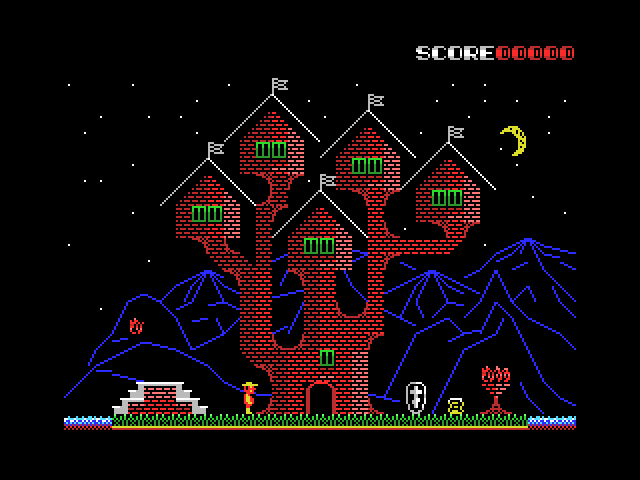
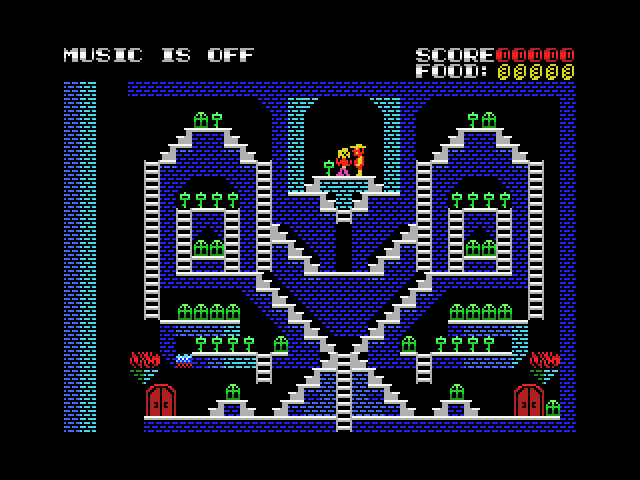
All the basic conditions of Pistoletov's mission are listed in a letter from General Avtomatov]], which Pistoletov can read immediately after entering Kashchei's 1) castle. However, many things are mentioned there only in passing and you have to guess about them yourself while exploring the castle. In particular:
- There are many kidnapped princesses in the castle, but only one of them is our agent and can help you. Guess how to distinguish her from the rest. There is a hint about this in the letter from Avtomatov.
- You cannot walk on water without waterproof boots and get into a fire without a fireproof jacket. But both boots and jackets have a relatively small resource of use, which ends quick enough.
- On vertical ladders, you can not only go up and down, but also jump from them to the side, if nothing interferes with the desired side (for example, there is no wall).
- You can get to inclined stairs using two cursor keys at once — LEFT or RIGHT, simultaneously with pressing the UP or DOWN keys.
- You can shoot (destroy) unnecessary or harmful objects from a pistol with the SPACE key.
- Doors are opened with keys, the shape of which is displayed above the door, but the connections between doors are not always linear. Entering the door from which you just left, you can go to a completely different place. However, there are also linearly connected doors. The transitions between the doors do not change with different walkthroughs and, once having studied them, it is convenient to use it in the future.
- Any door can be opened not only with a suitable key, but also without a key, by shooting at it with a pistol. However, most often it does not open with the first shot. The number of bullets in each pistol is limited and they can run out before you open the door. You can enter the open door by pressing the UP or DOWN arrow.
- There are places where it is impossible to get out without installing stairs, which you can find in the castle, and then stack on top of each other using the GRAPH. Therefore, the more pistols and ladders you have, the more confident you can feel while completing the mission. Boots and jackets, sometimes, are also vital. Do not forget about them and try to have them in stock too.
- Each new item you pick up goes to the first free space on the left in your list of items, if there is such free space. Otherwise, it ends up in the very right place.
- Therefore, even Tikhonenkov2) can sometimes be used with benefit — freeing up space for new findings, since he eats only those items that are to his left. In addition, sometimes you can use him as a key for a suitable door. But more often he has to be shot with a pistol when he blocks the road. However, keep in mind — if he turns out to be the right one in the list of your items, he will eat everything!
- Blue magic wands, which you sometimes come across in the castle, open the blue vertical walls.
- There are several places, stepping on which you unexpectedly fall down. However, most often this is not fatal and there are very few such places. You need to know them and be able to distinguish them by rather small signs of coloring.
- Don't forget about food. Bread, which is located in the upper right corner of the screen, is consumed rather slowly, but its stocks sometimes need to be replenished. This resource is consumed in real time and, if it runs out, Pistoletov will die of hunger.
- Generally speaking, your mission consists of several tasks. You must find the princess–agent and bring her a disguise headdress (crown), then get a magic apple for her, and only after that she will give you an empty pot, filling which with water, you can extinguish the flame in Kashchei's room. It is also necessary to stock up on enough waterproof boots to get to Kashchei himself. But do not forget, besides this, to find, break and destroy the magic egg with the needle, which gives Kashchei immortality. After all this, you can safely approach Kashchei and arrest him.
In last versions of “Major Pistoletov” has become much more player friendly. Many places where the player unexpectedly found himself in a stalemate have been changed. (In particular, the stairs were extended down so that you can first look around and understand where you have to fall or jump). Additional chests and items have appeared, explicitly spread across locations. Increased the likelihood of opening doors with shots at them. Gromkonenkov finally acquired his real name — Tikhonenkov. The entourage of individual locations and even Kashchei's room has been slightly changed. So, you can enter it now even without a pot filled with water but simply by stocking up on a sufficiently enough amount of fireproof jackets! However, in this case you will not receive a favorable reaction from “our” Princess. But the mission will be completed successfully. Now you can shoot at the bottle near Kashchei and even break it. And after successfully completing the game and leaving the castle, enjoy the spectacle of Major Pistoletov shooting the moving Tikhonenkov in front of “our” Princess–agent. In addition, the game now has the option to turn off the music with the TAB key. The message about that appears at the top left of the screen at the beginning of the game. The same key can be used to turn on the music again at any time.
“Pistoletov at the factory” — User guide
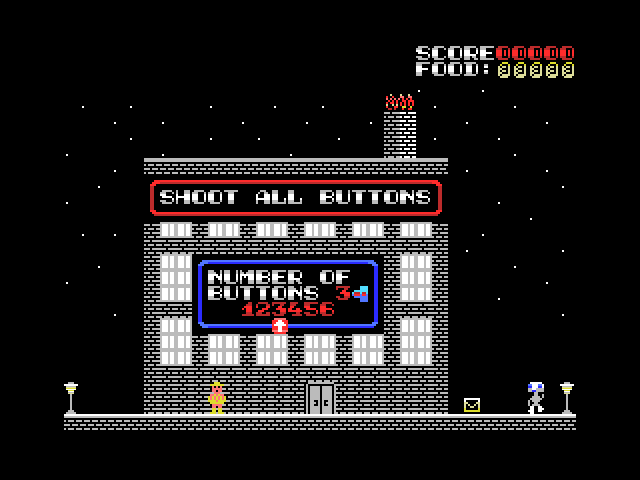
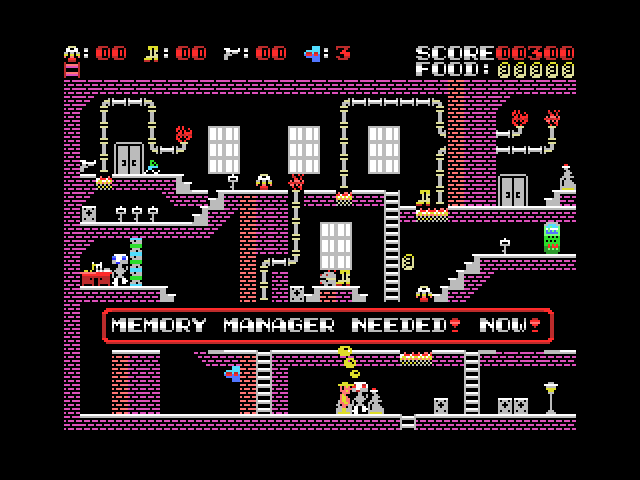
The game is similar to the previous one, but it has a different plot, a different building that Pistoletov falls into, a different topology of the doors and transitions between them, different graphics and attributes. This is a more difficult and more interesting game where Pistoletov has the rank of lieutenant colonel. Pistoletov's task is to shut off the broken Robot–Director, who began to disassemble his subordinate robots for parts. Factory workers (robots) can give you useful tips on how to do it in the best way, they can talk to you about other topics, and sometimes ask different questions.
In order to disable the Director, you must first hack his firewall, the control buttons of which are located in different rooms of the plant. These buttons must be sought and shot with a gun. The number of buttons to be destroyed is chosen by the player at the very beginning of the game and is in fact the choice of the difficulty level of the game. The game has undergone a lot of changes compared to its original version. These changes affected both the location map, which was completely redrawn, and the game code, which was rewritten.
ONLY FOR DISK VERSION OF THE GAME: Game state can be saved or loaded from chosen disk.
“Danceroid” — User guide
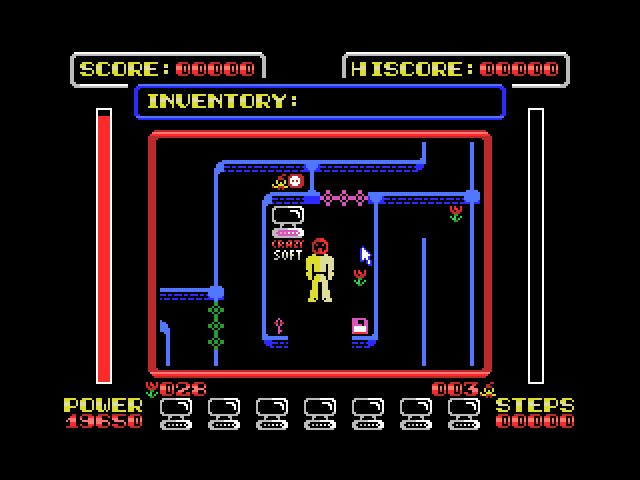
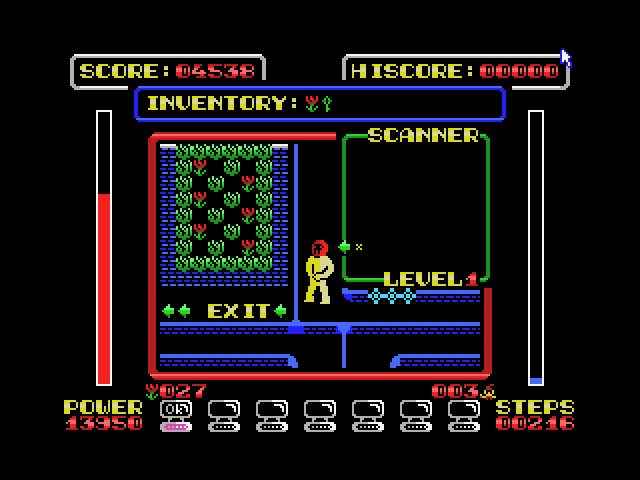
The game plot is very simple at first glance — you need to help the Robot to get out of the Labyrinth, switching on the computers using keys of appropriate colors and inserting floppy disks of the same color into these computers, thus opening the doors of corresponding color in the Labyrinth.
On your way, you can collect flowers and recharge at electrical outlets located in the Labyrinth. However, sometimes Gnomes block the road, which prevents you from going further until they are given a flower. Having received one or more flowers, the Gnome will thank you and disappear, clearing the way, but at the same time, he will clone himself into different parts of the Labyrinth in accordance with the number of flowers he received, and the
Difficulty Level selected at the beginning of the game. Thus, the resettlement of new Gnomes in the Labyrinth creates new obstacles on Robot’s way to the Exit (the location of the Exit can be seen on the Locator by pressing the GRAPH key).
Excessive replication of Gnomes in the random parts of Labyrinth can lead to a complete blockage of the passages in the Labyrinth, even if there are flowers remaining.
In order to give Gnomes less flowers, thereby reducing their propagation ratio, the Labyrinth provides waste bins, approaching which you can throw away extra flowers — both all at once, and one at a time, moving away from the waste bins after each discarded flower. Gnomes can also be given flowers not all at once, but one at a time, moving away from the Gnome after each flower given to him — in this case, the Gnome will not disappear, but will not replicate either. The Gnome will disappear from the path only when the last flower is given to him and on condition that the Robot is next to him, so that the Gnome can say ”Thank you!” to Robot.
That's all the rules of this game. It remains only to add that if the game is running on MSX2, then the game can be controlled not only from the keyboard, but also with the mouse. By clicking the left mouse button anywhere within the red frame, you can point the direction for Robot to move, and by holding the left mouse button pressed near the red frame or on it, make the Robot move continuously in the chosen direction.
The right mouse button turns on the Locator in the same way as the GRAPH key on the keyboard. Mouse can also be used at the start of the game to select the Level of Difficulty, as well as for applying the items that Robot picked up on his way through Labyrinth.
Bonus programs
By the way, if you're persistent enough to read this far, and if you're the proud owner of an MSX2 machine like the SONY HB900 that was onboard of the Soviet space station MIR, you can also use your MSX2 computer for pre–flight preparation. Practice the moon landing, check your health with biorhythms, and be sure to synchronize your clocks so you don't miss your flight!
Bonus programs for MSX2 can be called with keys F1, F2 and F3:
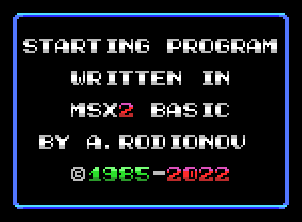 |
|
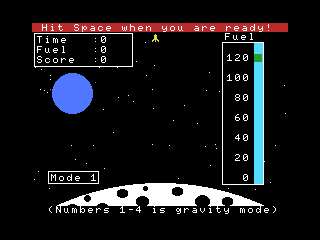 F1 — Moon landing | 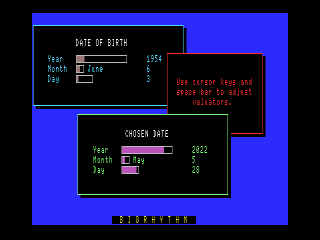 F2 — Biorhythms |
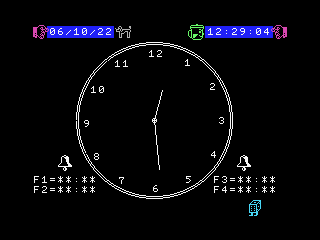 F3 — Alarm clock | 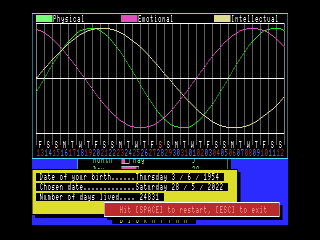 |
Collage
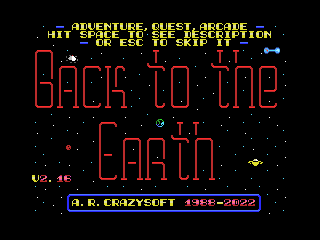 | 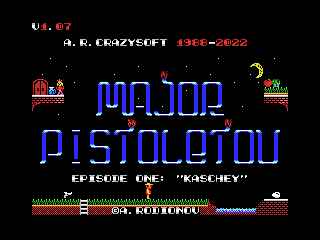 |
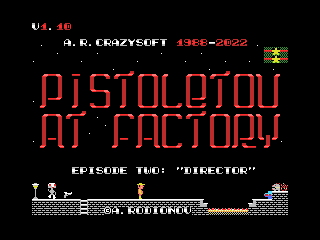 | 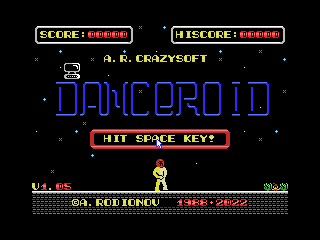 |
 |  |
 |  |
Links
The most common feature of tales involving Kashchei is a spell which prevents him from being killed. He hides his soul inside nested objects to protect it. For example, the soul (or in the tales, it is usually called “death”) may be hidden in the needle that is hidden inside the egg, the egg is in the duck, the duck is in the hare, the hare is in the chest, the chest is buried or chained up on a far island. Usually, he takes the role of a malevolent rival father figure, who competes for (or entraps) a male hero's love interest (Princess).
